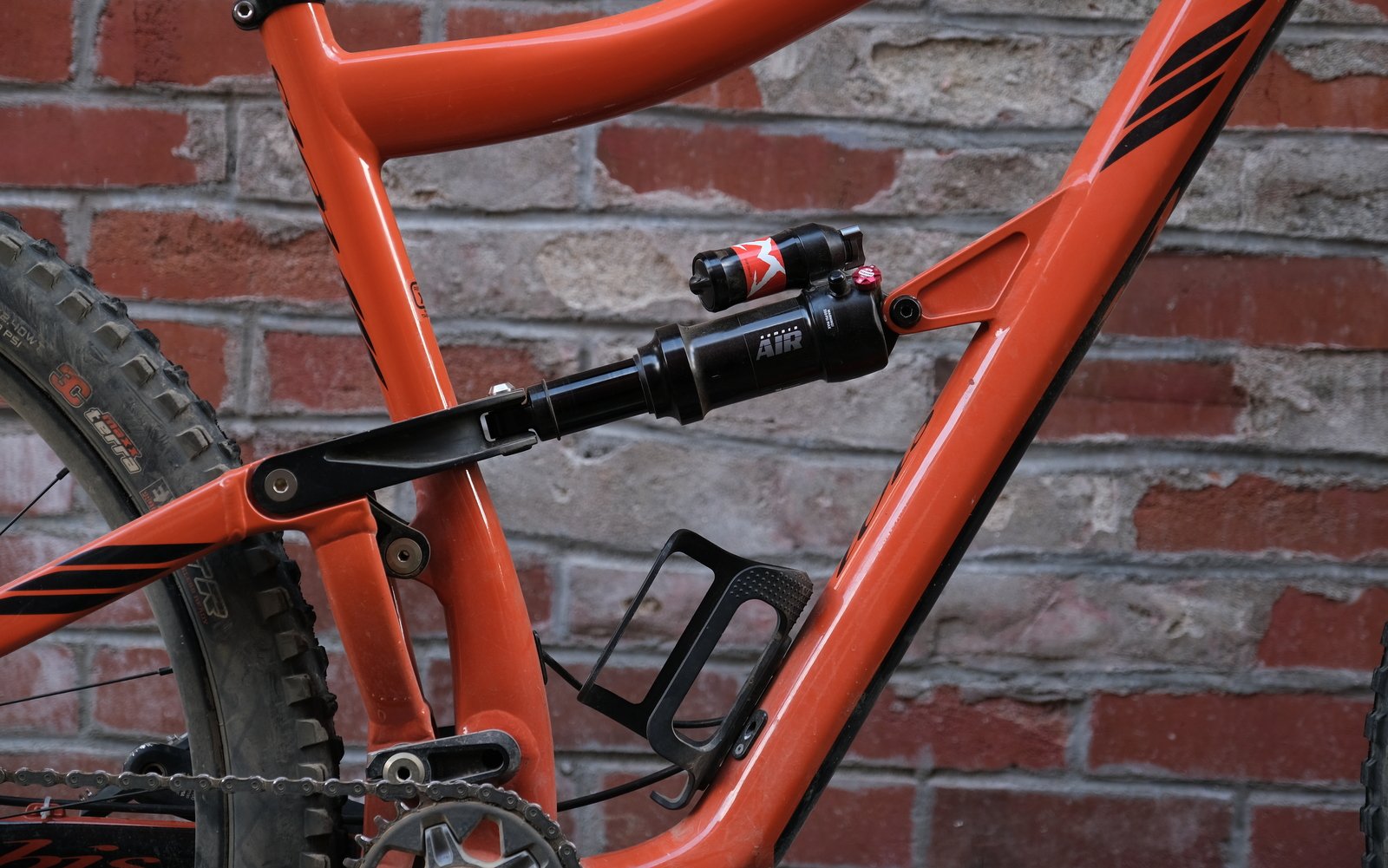
REVIEW
Marzocchi Bomber Air Shock Review
If you read my Ibis Ripmo AF review, out of all those words you can dig out that I liked that bike but I felt like it was a bit soft for my weight and riding style. Ibis has purposefully gone with a light tune, and stresses that fact repeatedly. As well, the leverage ratio really encourages the bike to settle in to the sag point and then flattens out once you do. This results in a really forgiving ride that will work well for many users, but it is soft. I found it to be especially noticeable when I put it head-to-head against the Canyon Spectral.
Once the Spectral disappeared, the Ripmo became my main ride and the platform for a bunch of test parts. I had an ambition to see if a different rear shock would change how the bike felt, so after some finagling, the Marzocchi Bomber Air shock showed up at my door. I’ve spent the last few months figuring out what this shock is about and if it has an impact on this bike.
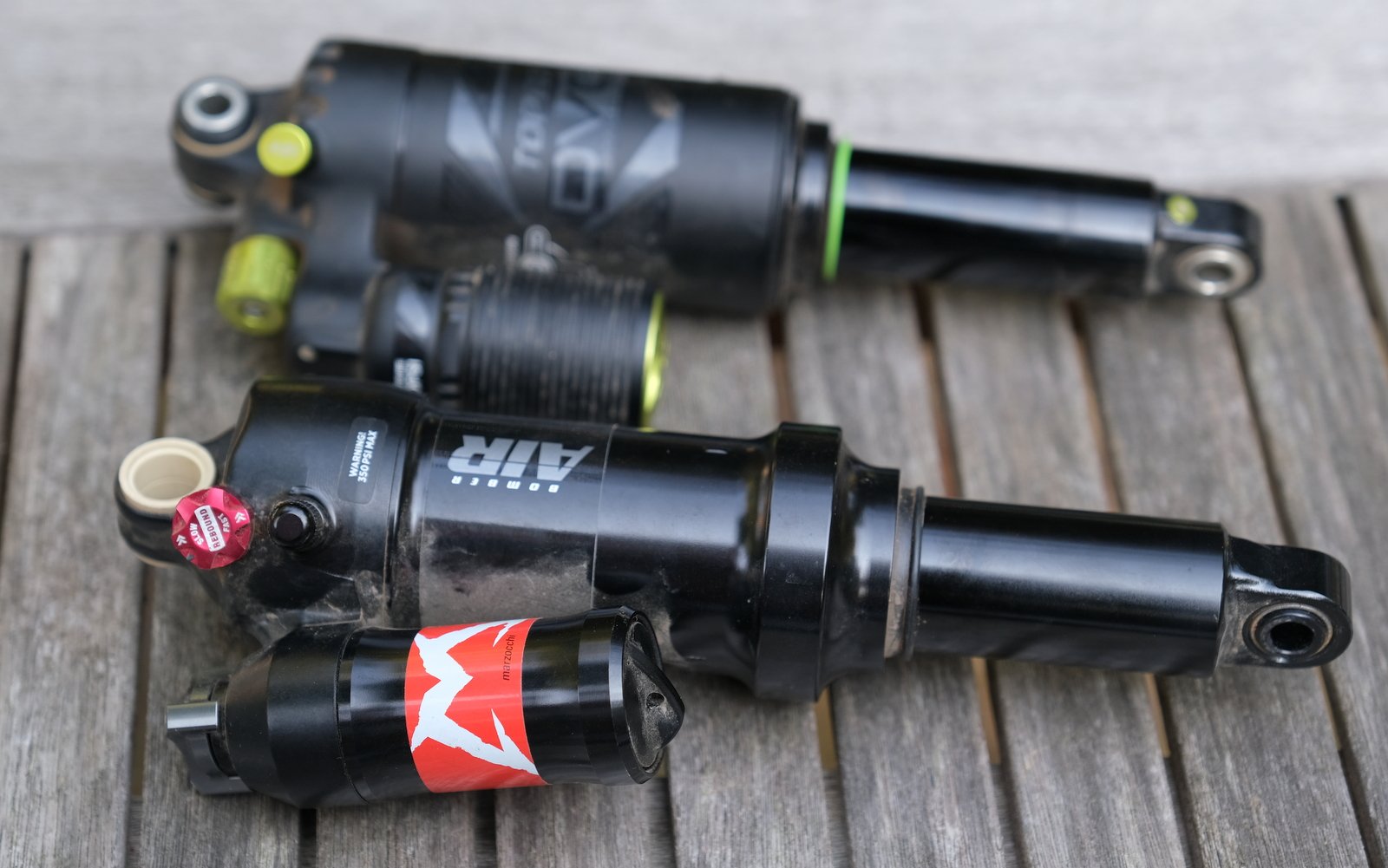
Out with the old, in with the new.
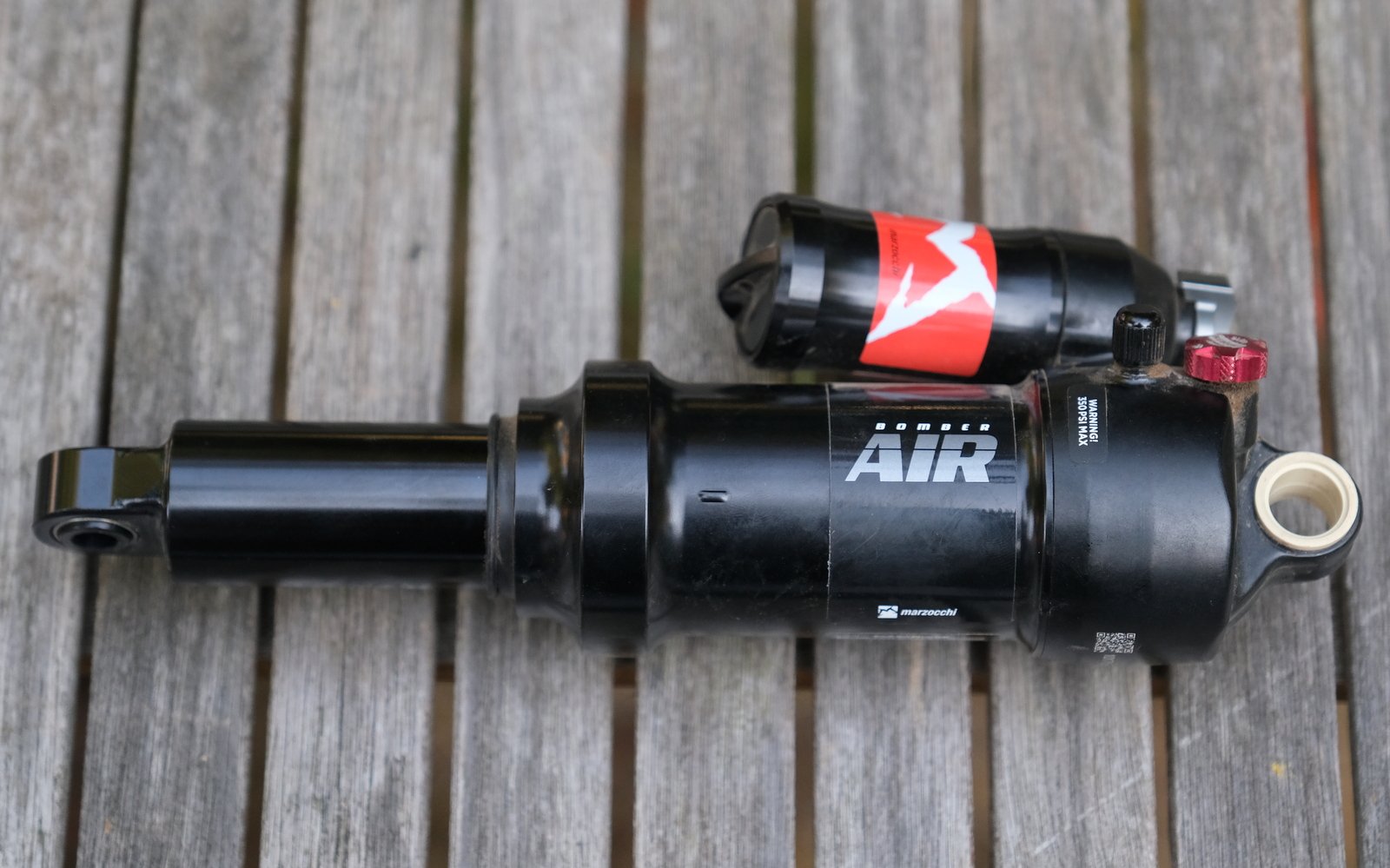
There she is.
On Shock Tunes
We actually had a bit of a small NSMB argument on stock shock tunes for aftermarket shocks. My feeling was that the Marzocchi tuning guide suggested there was one stock tune shipped on aftermarket shocks. Others felt like this was nonsense. So I directly asked Marzocchi about this:
All Bomber Air shocks equipped by OE will have a bike/frame geo specific tune. All Bomber Air shocks sold by themselves come with a middle of the road “normal” tune and amount of volume spacers that is designed to work with all suspension designs and riding styles. The Bomber Air is very adjustable and can be adapted to your bike and how you ride it. A perfectly optimized shock might provide some additional performance benefit but a new shock nearly always rides better than an older shock. Adding/removing volume spacers will be the same procedure as folks are familiar with across FOX air shocks. And finally, if you were seeking a more frame/bike specific tune, it can be done by a registered service center or tacked on as an upgrade during a standard service interval.
I put this at the start of the review because I feel like it’s a fairly critical piece of information. Anything that I say about ride performance is going to be quite specific to my weight (195 lbs.) and bike (Ibis Ripmo AF). Lighter/Heavier riders and bikes with less/more leverage are likely going to get different results out of this shock.
This also opens up an interesting can of worms about aftermarket rear shocks in general. If I were searching for the best bang for my buck using my own money I would have sent the stock shock back to DVO and asked for some tuning tweaks to suit my needs, rather than forking out for a shock that may or may not have the correct tune for me.
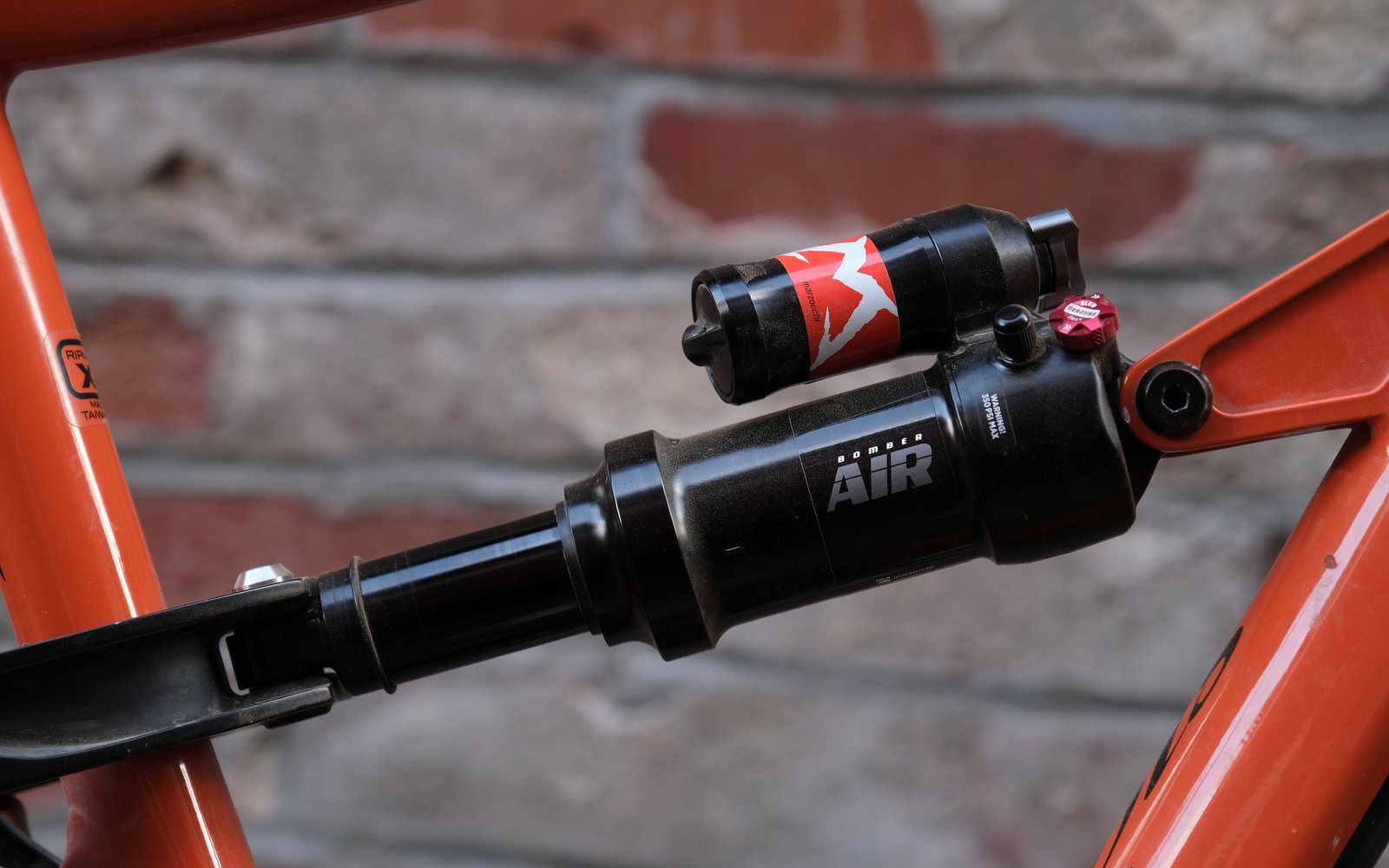
No challenges on the install, once I tracked down the correct bushings. The piggyback isn't huge and this shock should squeeze into lots of frames.
What the heck is it?
When this shock came out a few months ago, there was a lot of speculation on what it was. “Looks like a Float X” was the first thing said by many. Marzocchi countered with “No, no! Look at it! This part here is crooked! And this knob is a bunch different!” While both true, it felt like there was probably more to find out here, one way or another. The Fox/Marzocchi people seemed a bit guarded on exactly how similar the two shocks are, so I reached out to Steve Mathews at Vorsprung to help me unravel exactly what this shock is and isn’t. I can’t imagine anybody in a better position to know these things and to explain it to me using small words and short sentences.
"This is basically a Float X for the most part (same main piston/valving, air can, seals), but with a different compression base valve. The base valve adjuster has a 180 degree "sweep"; which is actually about the same as the Float X in function and range (speaking strictly in terms of the amount of oil flow it allows through the LSC circuit at maximum and minimum, not necessarily exactly what your min/max range of compression damping is), except they saved all that money on detents. The base valve piston machining however is quite a bit simpler, with one preloaded valve providing the climbing platform as well as the high speed circuit which means your lockout platform is tied directly to your HSC valving preload, whereas the Float X/DHX has two separate circuits for that (so you could conceivably preload the lockout to make it very firm without making any change to the main HS circuit or vice versa). If you're not actually a suspension tuning company though, the main practical differences are that you don't have a lockout lever, and that you don't have detents on the compression adjustment which is a bit annoying IMO especially given that it saves so little cost (they already have machining operations in the space the detents would go, it would cost them almost no extra per shock to have detents - maybe a few cents). The off-axis reservoir thing is pretty weird in that context, given that it then goes and increases the manufacturing difficulty again." - Steve Mathews, Vorsprung Suspension
This answered many of my questions, and created some more. After a lot of back-and-forth, I’m come up with this finalized, simplified version of what I think is going on:
- The piston, seals and air can are identical to a Fox Float X.
- The base valve is simplified and different than a Float X. The Float X has two separate, adjustable circuits and the Bomber has a single circuit with an adjustable low speed orifice. There are also no detents on the compression damping adjuster.
- The reservoir on the Bomber is different than a Float X, in that it is angled and it houses a different base valve, but everything else is the same including the IFP.
- The rebound damping adjustment is the same as the Float X, with only a low speed orifice adjustment.
- While all of the damping adjustments are “low speed” in theory, these types of orifice adjusters tend to have a significant impact on high speed damping, particularly for rebound.
- Volume spacers are specific to this shock due to the different base valve geometry.
What that means exactly is an interesting question to unravel. The good news here (I think) is that most of the parts are shared with a very common Fox shock. Replacing wear/service parts shouldn’t be all that difficult. Indeed, have a look at the schematics for the Bomber Air and the Float X and you’ll see a lot of duplicated part numbers.
You can also probably extrapolate conclusions for this shock based on the Float X. Durability of the Float X seems pretty good, as does performance. Much of what is said about that shock should hold for this one.
The big difference though, is with the compression valving. If you believe the literature, the aim for this shock was to give people an easy to process, set it and forget it shock experience and to accomplish that they’ve eliminated the climb switch and simplified the compression adjustment. Is it simpler though? I mean, there’s definitely no climb switch and one knob that turns a half rotation is about as simple as can be. It gets a bit murkier when you try to speculate on whether that actually simplifies how you interact with this shock, and who might benefit from such a thing.
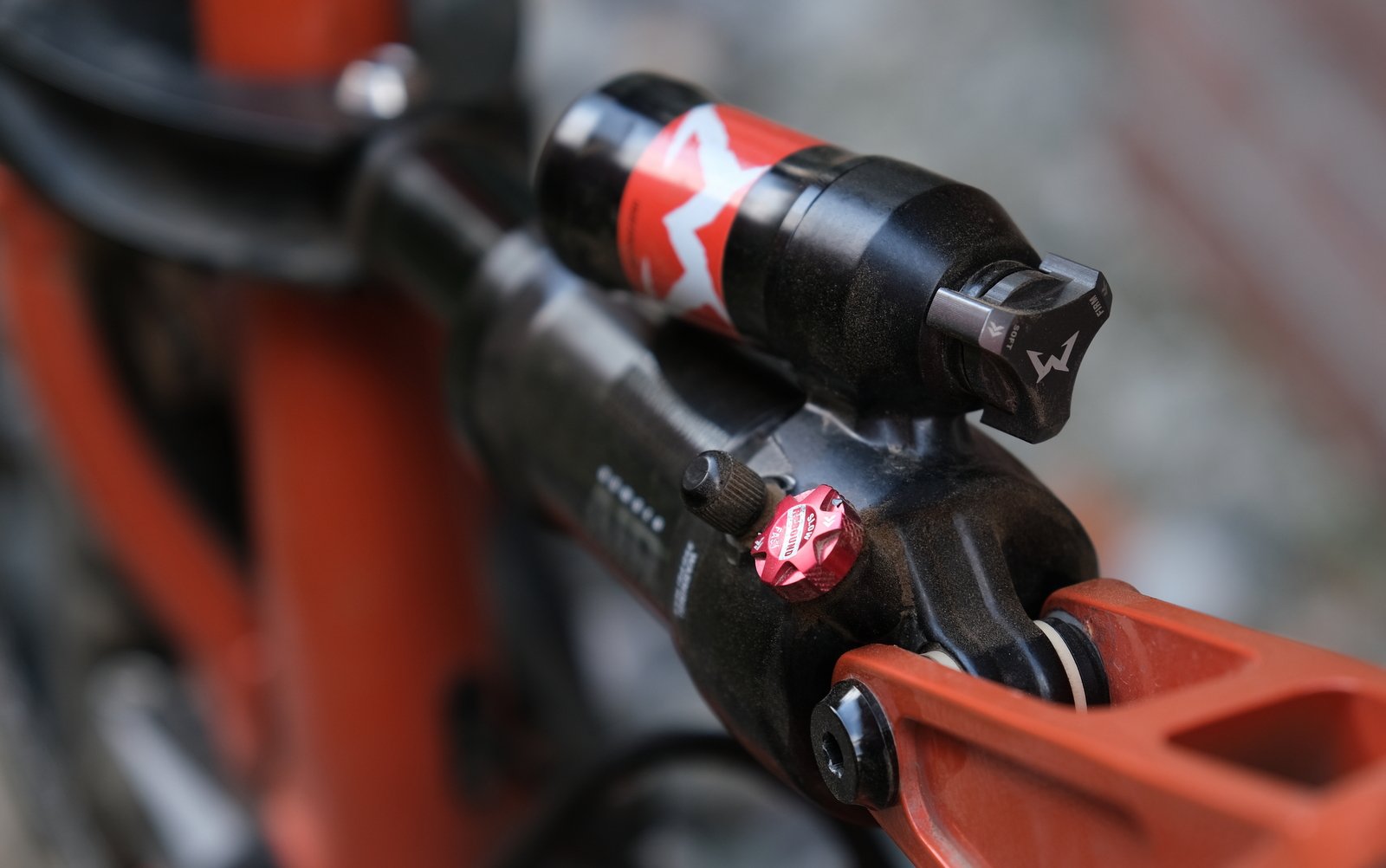
Crooked and sweepy.
Tuning
Putting this all together, tuning your new Marzocchi Bomber Air shock is a pretty basic affair, with a setup guide to match. Set your sag to that recommended by the bike manufacturer. Dial in the low speed compression until you’re happy with it. Start your rebound at what Marzocchi recommends based on your air pressure. Go from there. You can use spacers to adjust the amount of end stroke ramp and you can twiddle your knobs a bit, but for good or ill, this shock has fairly minimal interactivity.
For me, I wound up at the same pressure and the same 15mm sag (27%) as I had on the DVO that came off the bike. I set the rebound by bouncing up and down on it a bunch and turning the red knob until things felt pretty good. And I really didn’t know what to do with the compression knob.
The compression knob does give a wide range of adjustment. It’s not quite a lockout when fully closed, more like a really firm trail mode…but Fox climb switches tend to be a bit softer so this isn’t too far off of that. Fully open there’s still a decent amount of low speed compression. Same with the rebound dial. It takes you from rabbit quick to molasses slow.
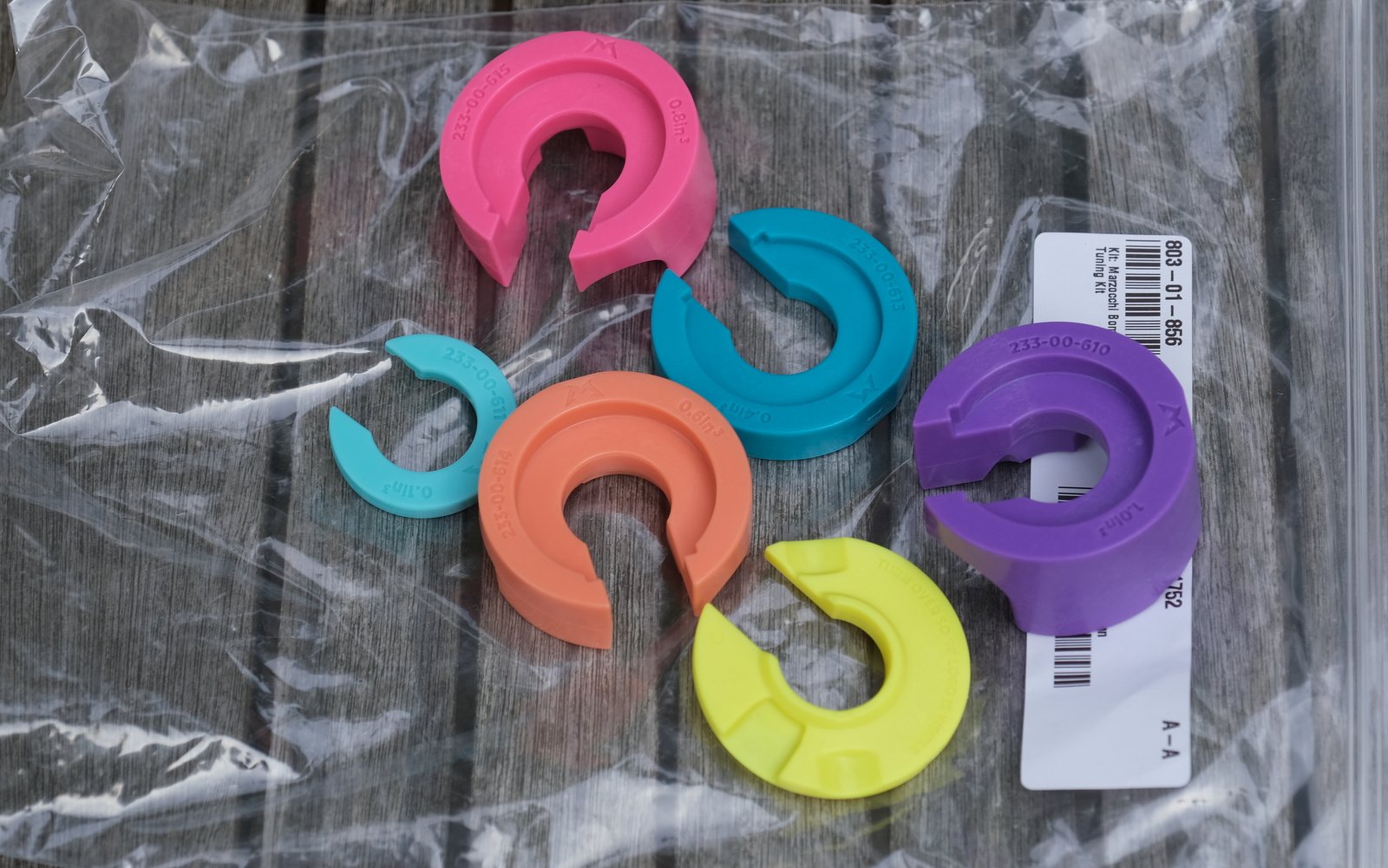
From small to large, you can see a huge swing in volume and a corresponding increase in progression.
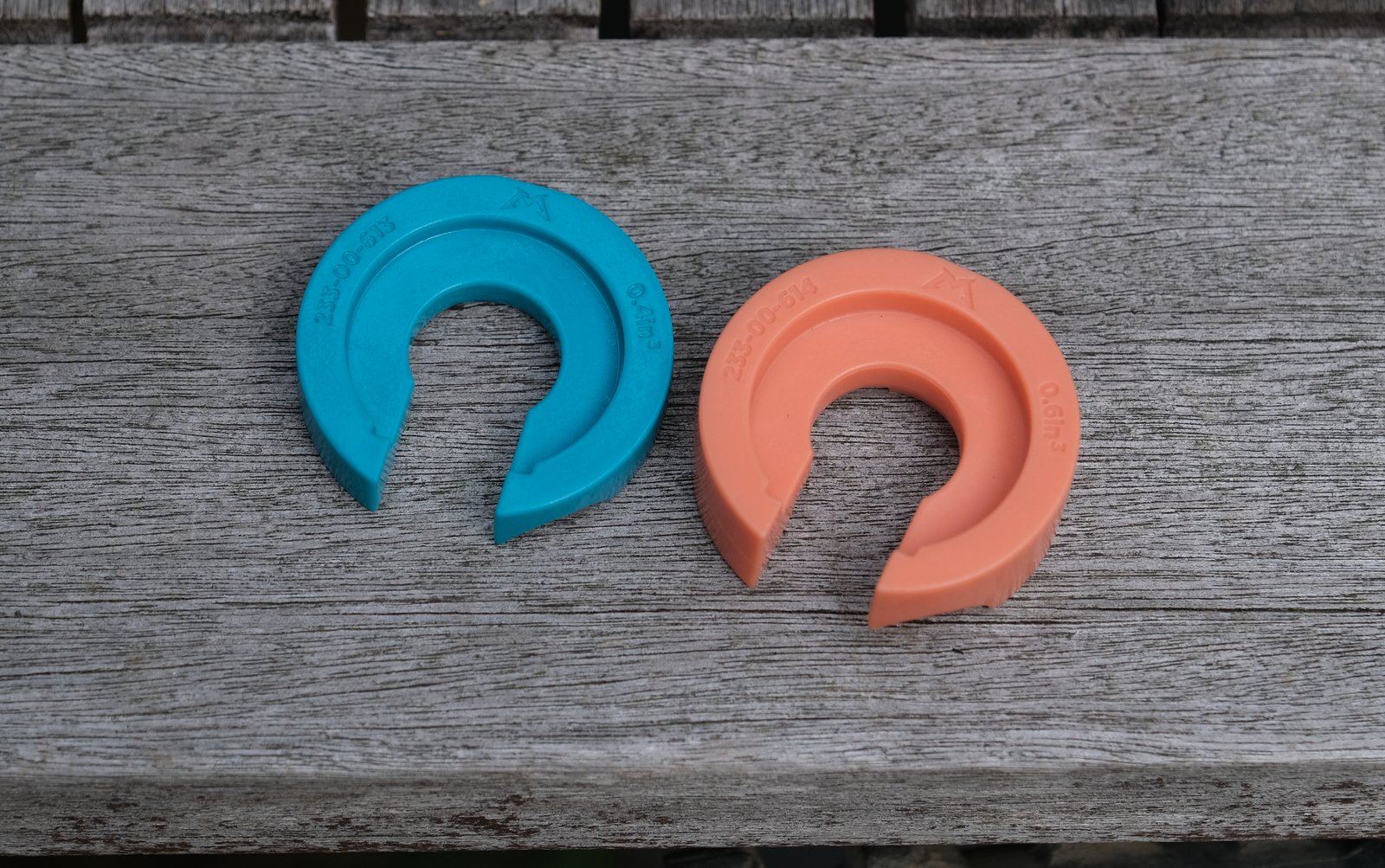
Blue is stock, orange is what I went to. I'll probably play around with one larger as well.
Riding the Marzocchi Bomber Air
Before we go too far I’ll just state the important part. The quick answer is that I don’t feel like this shock fundamentally changed the underlying characteristics of the bike. The bike feels pretty soft and it uses full travel fairly easily. It’s supple in the initial stroke, has lots of climbing traction and eats travel once the speeds pick up.
That said, it is different, and it is better (again, for my style and weight). The first thing I noticed was the slightly heavier low speed compression tune. Even fully open, low speed compression is firmer, and you can feel this at most points in the shocks travel. The shock rides higher through the middle and is just a bit more controlled. The range of rebound is broader as well, which worked for me as I was nearly fully closed on the DVO. Hopping back and forth between the DVO and the Bomber, it always took a bit of adjustment going back to the DVO, but I could plunge right into things on the Bomber. Overall, the shock feels less nervous and more in control.
The other thing that helped was the really generous amount of tuning you can do using volume spacers. The shock comes with a 0.4 cubic inch spacer installed. The (not included) spacer kit includes a 0.1, 0.2, 0.4, 0.6, 0.8 and a 1.0 cubic inch spacer. The spacers are not stackable, but this should give you a wide range of adjustment from nearly nothing to a substantial reduction in volume. These are going to have more of an impact on your final spring rate than a couple of thin bands of plastic or rubber. Note that not all length/travel combinations can handle the larger spacers.
Moving up to a 0.6 cubic inch spacer was the final piece of the puzzle for me. This made the shock more progressive which lead to better bottom out resistance. It’s not like the bike was clanging off the stops or anything, but a bit more bottom out resistance helped for me. It didn’t have much of an impact on the rest of the ride, but I finished each ride with a bit more travel left in the tank.
Overall, the bike felt better. Nothing against the DVO, as it is doing exactly what Ibis wanted from that shock, but the stiffer tune and increased bottom out resistance allowed me to push the bike a little bit harder, and with more control.
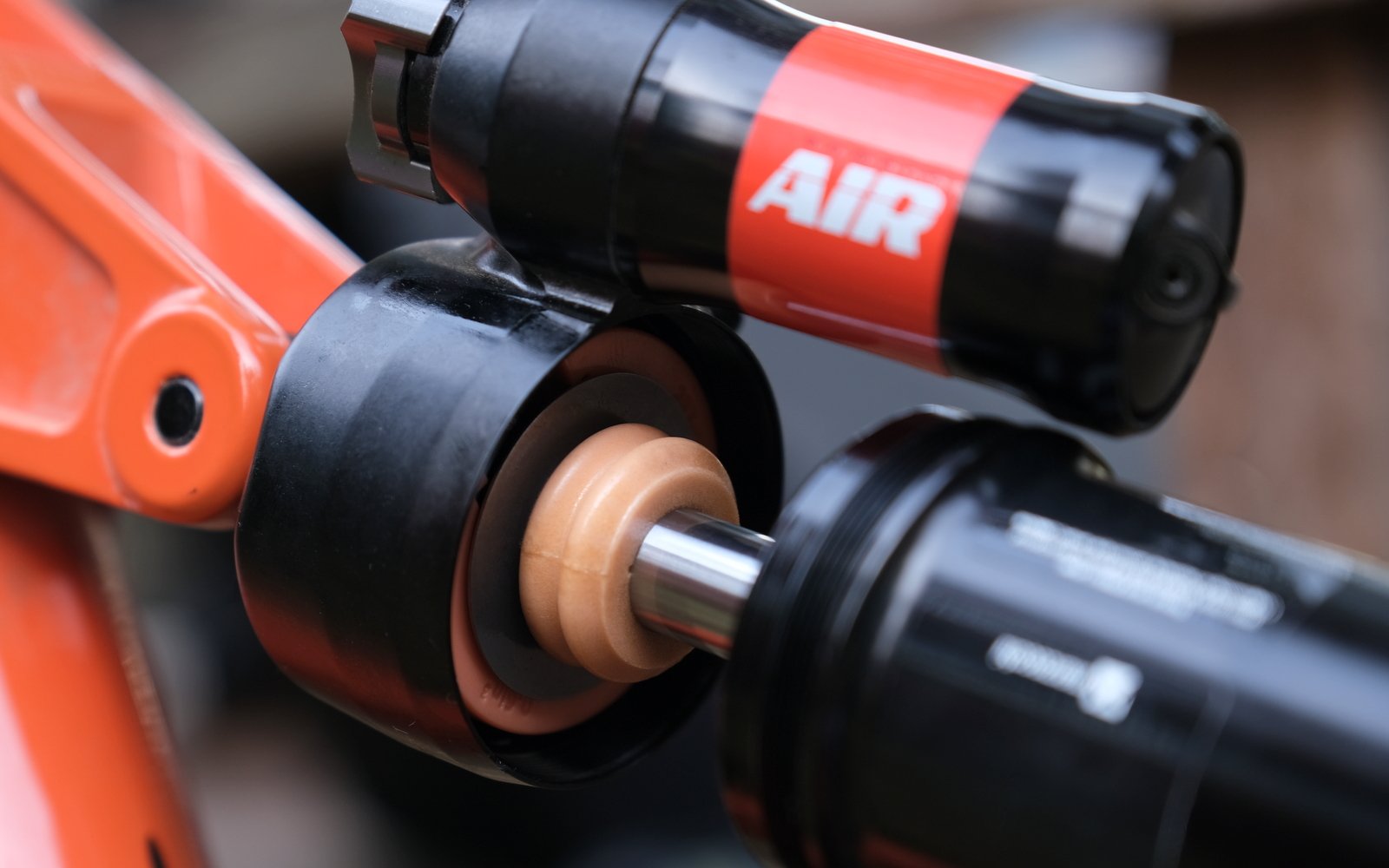
Opening things up is pretty simple. You can see the healthy bottom out bumper on top of the volume spacer. Each volume spacer sits in the same spot and volume changes take place out of view. Pumping the shock back up afterwards is probably the most labour intensive part of this job.
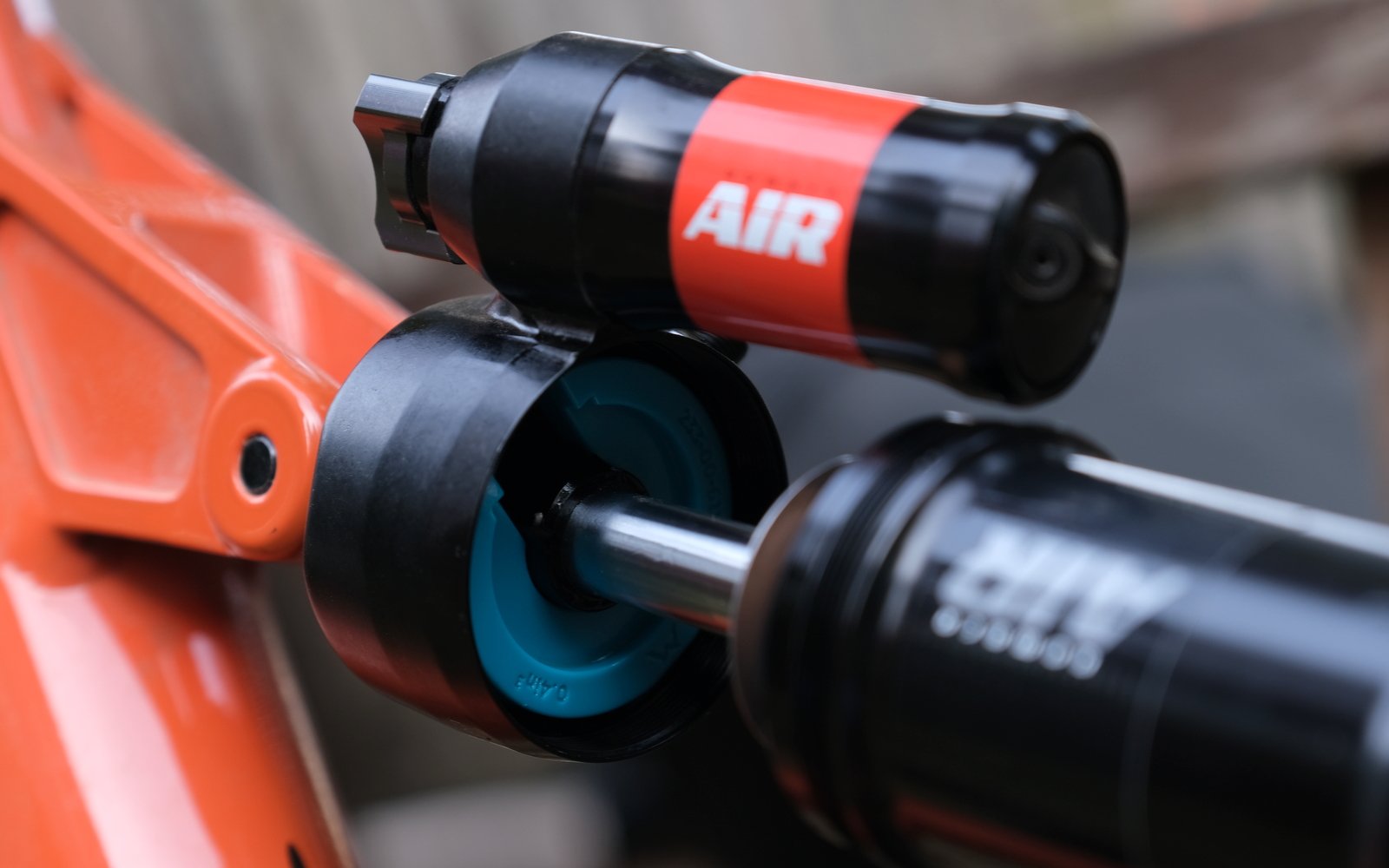
The stock spacer.
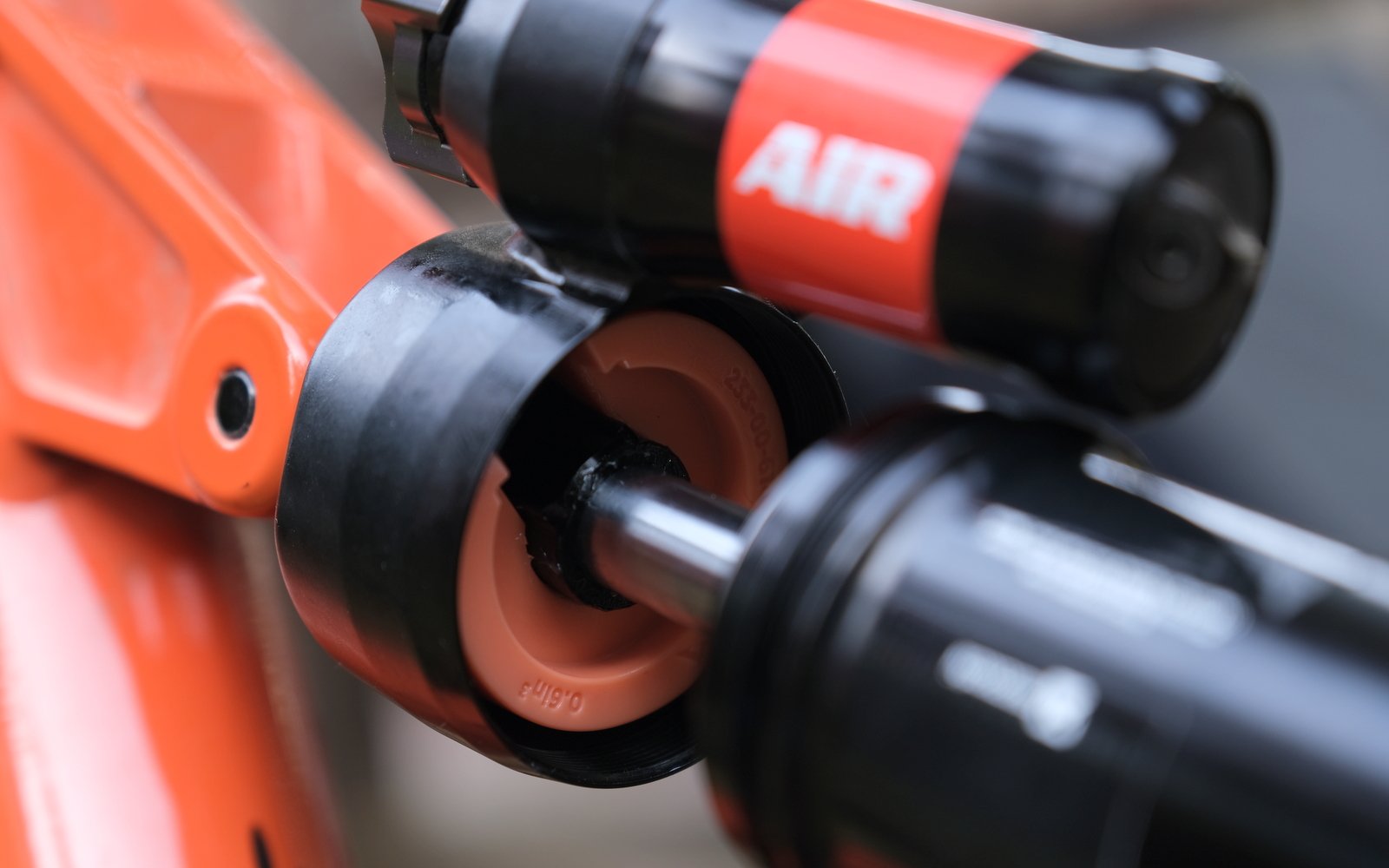
Swapped for something that takes up a bit more volume.
What about the compression adjustment?
The primary differentiator between this shock and the Float X is how each handles low speed compression damping adjustment. Fox has the classic climb switch and then your standard tooled adjustment with detents. Marzocchi goes with no climb switch and a tool free adjuster dial. I’ll throw it back to Marzocchi to explain why they did this:
The Bomber Air is intended to be in-line with the Marzocchi family and complement the playful and supple ride styles expected for folks balancing the desire between a coil and an air shock in our lineup, and covers a huge breadth of riding styles/sizes, from 95mm to 205mm shock lengths. The concept here is a single, bomb-proof shock that would replace the need for selecting from different Float shocks (Float DPX2, Float X, Float X2) from Trail to DH.
User experience is in line with Marzocchi products – a simplified sweep style compression and rebound dial that have the same adjustability you come to expect from Marzocchi, but with a simple feedback and quicker change between “stops” to keep it easy to tune to feel, different eyelet structure, different reservoir shape for easier fitment and access to sweep dials.
This almost feels a bit backwards to me, as I find the classic Fox setup to be much simpler. Set your low speed compression once and then flick your climb switch a few times each ride. Isn’t that easier to understand than an unlabelled dial? I honestly found myself struggling to know what to do with that knob at times. Sometimes I’d turn it all the way hard before a climb, and sometimes I’d dial in a quarter turn or so if I was riding faster, mellower terrain and wanted to be able to push into the bike a bit more. If I was a constant fiddler, maybe that easy to access knob would be just what I’m looking for. I’m not though, as I tend to leave things as they are once I’m happy with my setup, so the general vagueness of a dial with no clicks or indicators left me feeling a bit uneasy every time I turned that knob. Where was I? How much farther did I have to go? Would I ever find my way back?
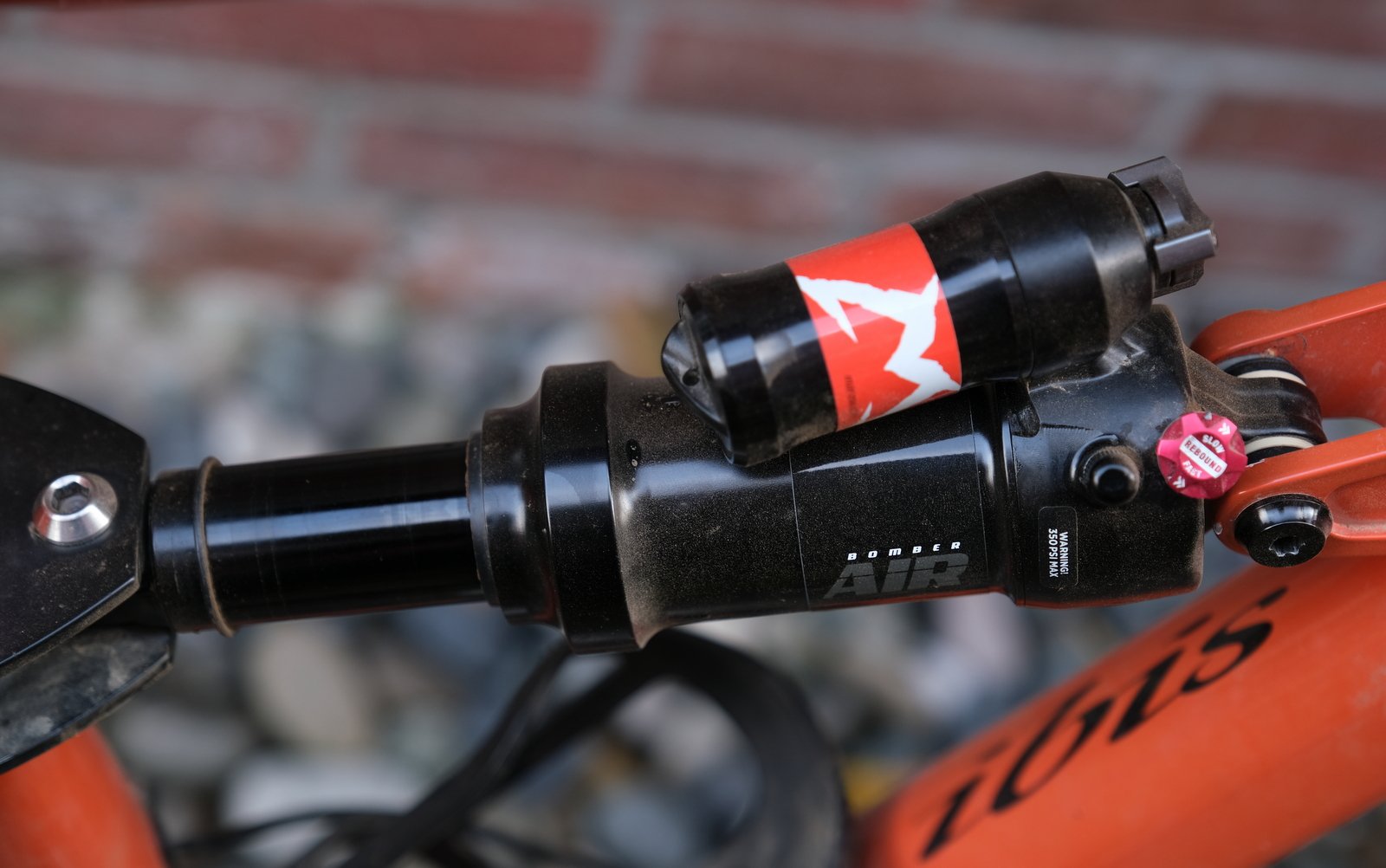
Overall, the shock does work as advertised. It doesn't have a whole lot of adjustment, but the tune worked pretty well for my needs.
In Conclusion
At the end of the day, there’s a fairly tight needle to thread between this shock and the Float X. The Bomber is a bit cheaper. At 479 US for the Bomber Air, you’ll get the shock and a meal or two at McDonald’s for the same price as the Performance Elite Float X (I’m seeing conflicting MSRPs of 499 and 519 US for that shock). The Bomber comes in a few more sizes, as well (190x45, 210x50/52.5/55,230x57.5/60/65 and 250x75, as well as trunnion 185x52.5/55, 205/60/62.5 and 225x75…Fox Performance Elite doesn’t offer all of those, according to the website). So, if you really don’t want a climb switch, or if your bike needs a size that isn’t offered in the Float X, this could be a win-win. If you do want a climb switch, or would prefer to accurately set your low speed compression clicks, then you should pony up for the Float X. I know what choice I would make.
So, wrapping things up, this shock worked well for me. It didn’t dramatically change the bike relative to the stock shock, but it subtly shifted the bike in several ways, each making it a bit better than stock (for me). If your bike comes with this shock (or the Float X), you’re in pretty good shape. If you’ve got a bike with a middle of the road compression ratio and you aren’t too heavy or too light it could also be a decent option if you’re shopping for an aftermarket shock. It saves a few dollars over the Float X and I guess it really boils down to whether you’d rather have a climb switch or a couple of Big Mac meals.

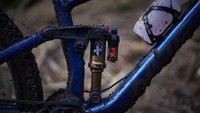








Comments
hongeorge
1 year, 5 months ago
I don't see the point of Marzocchi stuff any more, supposedly a budget range, but in practice the identical (or slightly better in this case) Fox Performance stuff is the same price or cheaper. Just seems total waste of the brand.
Reply
cheapondirt
1 year, 5 months ago
Creates the illusion of choice.
Reply
bishopsmike
1 year, 5 months ago
So true. 96% of the Fox MSRP is not a budget offer. They need to either differentiate Marzocchi (cheaper, burlier, coil options, inverted forks, whatever) or just stop. Shit, for the price of developing this almost-identical sku, Fox probably could have just lowered the price of the Float-X.
Reply
kcy4130
1 year, 5 months ago
Nostalgia is the point. But seriously, I have a Z2 on my hardtail and like it. Basic, but works fine. For forks fox performance is significantly more expensive than Marzocchi.
Edit: But yeah, why fox doesn't just sell the rhythm forks aftermarket instead of Z1/Z2..? Marzocchi coil forks exist, which is different. Mostly marketing reasons I'm guessing.
Reply
Mammal
1 year, 5 months ago
Good review, and as a Ripmo AF owner, it doesn't surprise me that a non-traction tune improved your overall ride.
With my bike (still the OE Topaz), I found the Cascade Link really transformed the ride. A bit more plush on initial stroke, and a very good ramp up between mid-to-end stroke gives better support when it matters most. The added progressivity allowed me to remove a few positive volume spacers (now using 1 instead of 3.5), which really helped the rebound stroke stay composed. Like you, I needed to almost max out the rebound adjustment. It was FAR too slow for low speed stuff, but completely required to keep me from getting bucked on lipy-er takeoffs or harder hits. The amount of positive volume spacers required for avoiding bottom out was overwhelming the rebound damping at full compression, and with most of those removed, the rebound damping was way more effective across the entire range of travel. I ended up running a touch higher pressure (+5psi) to firm things up a tad overall, and the descending experience really transformed.
I'm around 175lbs, and I can totally see how slightly heavier riders or harder smashers than me would be best suited for a custom tune (heck, I probably could too), but I feel like the lack of progressiveness in the frame is a separate issue. That particular issue is addressed really well with what Cascade has done with that link.
Reply
Justin White
1 year, 5 months ago
"but completely required to keep me from getting bucked on lipy-er takeoffs or harder hits"
Rebound damping doesn't cause or prevent getting bucked. Slow rebound (lots of damping) can help you make a save after getting bucked, but the buck is caused by a compression event. If you're getting tossed out the front door on big-hits or rampy take-offs, then compression damping needs tuning, not rebound. Or you're not pushing into the take-off hard enough or long enough, but in any case, a take-off is a compression event, not a rebound event, so more rebound damping isn't going to help control much of anything take-off-wise.
*(might be too much damping, seems obvi, but also might be too little and it's blowing through to bottom-out, or close enough to bottom that the progression ramp hits hard)
*(well, unless rebound is so slow that's it's packed up from a janky run-up and is unexpectedly deep in the progression when you hit the lip or hit, then rebound tuning might help, but it's still compression events causing the issue, and a lack of rebound events that exacerbates it)
Reply
Mammal
1 year, 5 months ago
The issue of getting bucked was much more pronounced when I was using a reasonable rebound setting for most riding cases, much less so when I jacked the rebound damping to almost-full. The only changes I made were: Cascade link install, fewer volume spacers, small psi increase, and rebound returned to a more moderate position. Much better now. For reference, my damping tune is a VERY light stock tune from DVO/Ibis, and the compression is not adjustable.
Although I agree that compression plays a role here, I disagree with your point that rebound damping doesn't play a part in that scenario. It's pretty easy to play with the rebound knob and feel how that happens. And a shock jammed full of positive volume spacers certainly kicks a lot harder toward full compression than it does during the majority of the stroke.
Reply
Justin White
1 year, 5 months ago
If you feel the effect of rebound damping adjustments on a take-off, then you're pre-jumping, spud-hopping or bunny-hopping, off the jump instead of riding off it. Should be pushing into the entire take-off, all compression. The wheels should not be rebounding until they're off the take-off, at which time they're not able to buck you, because they're in the air. Being able to feel the rebound damping on jumps (with smooth take-offs) is actually a great way to self-diagnose pre-jumping or your "strong/attack/jump position" collapsing before the take-off.
Reply
Mammal
1 year, 5 months ago
FYI, the situation I'm describing isn't isolated to jump scenarios. It includes any situation where there is a bump and launch, or double drops with a quick substantial compression to lofting off the second drop.
For jumps, I use the same technique I always have whether riding my trail bike or my DH bike, and don't have any issues like this on my DH bike. Agree to disagree here.
Reply
Dave Tolnai
1 year, 5 months ago
I feel like you're speaking with perhaps a bit too much certainty, in what is a fairly uncertain sport. Perhaps under ideal circumstances - a perfectly radiused jump - what you say holds. But as Mammal points out, there's more to jumping a mountain bike than perfectly radiused jumps. What if there's a tight radius and then a flat section? What if the jump is just a two foot little lump in the middle of a trail? What if, what if. I feel like under some of these circumstances you're definitely going to want to have your rebound sorted out.
Reply
Onawalk
1 year, 5 months ago
Maybe, but as fancy apes we really like to believe the issue is with the equipment, rather than our own abilities/skills, etc.
Mammal notes that he’s not having the same issue on his DH bike, and he’s prolly not, cause the DH bike is faking it a bit for him (possibly, I really don’t mean any disrespect to anyone’s ability, style, etc).
What I can say is, that for the most part, jumping on your trail bike requires better form than on your big bike, the window to get it wrong is much bigger on the trail bike.
Couple that with the fact that we mostly have poor form, and riding tired, etc, and that trail bike requires more work to go fast, and I’m willing to bet more time and energy spent on some quality coaching/fitness would go along way here.
Again, Mammal, not meant directly at you, just speaking about our little niche group in general.
It’s rarely my equipment, it’s usually that my form and focus has diminished due to…..well life I guess.
Sam Hill can go blazingly fast on his trail bike, cause that’s what he does, he has the form, fitness, and focus to do just that. And do it well, and with near precision consistency. If I climb an extra couple kms on my trail rig, it can have a drastic effect on the outcome when decending.
Mammal
1 year, 5 months ago
Replying to Onawalk -
I don't have that issue on my DH bike, largely because it uses a coil shock (linear spring rate). It isn't storing a whole bunch of extra energy as it compresses toward bottom-out, and then releasing that extra energy in the beginning of the rebound stroke, as happens with an air shock jammed full of volume spacers. As mentioned before, this is not just an issue I have with jumps, it's other similar events where the shock is loading up and spitting out, and an overwhelmed rebound circuit plays a role here, as does a rapidly increasing spring rate toward the end of the compression stroke (to credit Justin's point above).
My initial comment was just to point out that the Cascade link helped calm down my spring rate and resulting rebound damping, by providing my needed progressivity through the suspension curve instead of the air spring.
I agree humans have a habit of pointing towards our tools as opposed to skills. I've been jumping hard tails, trail/enduro bikes and DH bikes for over 20 years now. I'm by no means a pro-level rider, but I can usually suss out what's going on with my bike if it starts behaving strangely in certain scenarios.
Justin White
1 year, 5 months ago
I didn't say having your rebound out of sorts won't effect getting to a jump, just that having it too fast is not a major, or even minor, cause of getting bucked off a lippy jump. And I'm also saying that in fact, because most things we hit on trails do not have perfect run-ins, the common "fix" of winding rebound it to be quite slow is actually more likely to get you bucked (packing up into the firm part).
commentsectionanon
1 year, 5 months ago
They most definitely do not feel the effects of rebound damping.
Any skilled rider knows that your body position plays more of a role than your suspension does in jumping. Just people who have to point out the fault lies elsewhere other than their own lack of skill.
Reply
commentsectionanon
1 year, 5 months ago
I don't know why this is being down voted. Its almost like the people in the comment section don't like being told they don't know how to ride...
Reply
commentsectionanon
1 year, 5 months ago
Thank you for specifying you own an Ibis. Now we know we don't have to take anything you say seriously.
Reply
Mammal
1 year, 5 months ago
Why do you feel the need to be so completely sh*tty in the comment section here? I purchased my bike because of the sheer value aspect of the frame, parts, and suspension that I can service myself. FWIW, I've got it to a really good place, it works well and fits well. Take your trolling negativity elsewhere if you don't mind.
Reply
Onawalk
1 year, 5 months ago
Replying to Mammal,
Apologies if anything I said came off as being a di&k, it was not my intention.
I’m sure you’ve spent loads of time, riding, racing, ripping, and jumping, I guess my experience with working with beginners to experts is more often or not, it’s body positioning, and not suspension setup. Just because it doesn’t happen on your DH bike, which can, and likely has a very different wheelbase, angles, speed of entry, etc doesn’t mean those skills translate over to trail bike.
Just something to review,
I see that some of the comments got fairly spicy let’s say, and don’t mean my comments to be.
Reply
Merwinn
1 year, 5 months ago
Likewise.
Reply
Mammal
1 year, 5 months ago
That guy is just a peach, tell ya what. I DM'd him to to find out where he was coming from with this Ibis comment, and that the community here expects/deserves better than offensive/trolling jabs. Summary of his reply to me:
Anyway, glad I don't need to read his toxic waste here very often. Here's to a nice little bike website community and respecting our fellow riders.
Reply
bishopsmike
1 year, 5 months ago
Wow, that's super helpful - I had been wondering why the bike industry sucks, and thankfully commentsectionanon stepped in and helped us all learn something.
You're completely right, it's nice that there are not many douches here.
Reply
Justin White
1 year, 5 months ago
[paraphrasing] all aftermarket shocks "come with a middle of the road “normal” tune" [/paraphrased]
Isn't that true for every manufacturer? Pretty sure all aftermarket RockShox shocks (ie: those that you can buy separately, and that are not take-offs) have the M/M tune (and "firm" lockout/threshold?)
Reply
Lu Kz
1 year, 5 months ago
Not exactly. You can order a handful of rockshox options a la carte tuned/sized for specific bikes at no significant upcharge... I haven't been on the dealer site in a while, but I think it's around a dozen in any given model year?
Contrast this with fox who, at least in Canada, stocks more limited options and requires a substantial upcharge to resize/tune/change stuff for those same bikes.
Reply
Justin White
1 year, 5 months ago
Dealer site? Like, for shops to order things? A bit different than consumer aftermarket...
Reply
Lu Kz
1 year, 5 months ago
Yes, for shops to order. Seeing as rockshox doesn't do direct to consumer sales in Canada, it's exactly the same as consumer aftermarket. The shocks are built and kept in stock at Canadian distributors, not built to order like fox options.
Reply
Timer
1 year, 5 months ago
I'm not even sure if that is a good thing or not. I'd guess the number of people who know so much about bike kinematics that they could chose a shock tune that is more suited than "middle of the road" but who don't want to give the shock to a tuner or do a reshim themselves is fairly small.
Possible smaller than the number of people who think they know better but chose the wrong tune and end up with worse suspension than they would have with a stock option.
Reply
Justin White
1 year, 5 months ago
They might not know so much about kinematics, but they may know how to look up* the OEM shock tune, and just want an aftermarket option that is closer to that original tune than "middle of the road".
*(Easy as pie if it's a Fox and still has the tune ID tag. Not sure how, but I think it's also possible to find that out for RS and others)
Reply
Graham Driedger
1 year, 5 months ago
Another hypothetical could have been that the shock was tuned by Fox/Marz for Dave's Ripmo off the bat. A stock shock with a one-for-all tune surpassing the custom tuned shock is worth talking about.
Reply
Dave Tolnai
1 year, 5 months ago
No custom tune for me. This was an off-the-shelf, middle of the road tune, just like anybody else would buy.
My suspicion is that we read too much into this whole "custom tuned" thing that the OEM's sell us. It wouldn't surprise me if many, many bikes are just ticking a check box beside one of a few options. Probably worth some investigation.
Reply
Graham Driedger
1 year, 5 months ago
Totally Dave - that's what I'm getting at. You found a higher ride quality with an off-the-shelf tune that exceeded the custom tune of the DVO, which is pretty rad.
I ordered a bone-stock DHX2 coil last year for my Altitude. It felt great. When it was time to service said shock, I had it tuned for the Altitude specifically, which opened up the compression circuit significantly (or at least feels like it did).
Reply
Timer
1 year, 5 months ago
Its not the first time we hear something like that. Remember the Banshee Titan review where Andrew liked the off-the-shelf TriAir and CCDB better than the "custom tuned" X2 that the frame came with?
Reply
Mammal
1 year, 5 months ago
FWIW, their are MANY complaints about the "traction tune" that Ibis uses (it's extremely light). It's often too light for harder or heavier riders, and with the DVO spec, it's combined with a non-adjustable LSC circuit (double trouble).
Reply
Jenkins5
1 year, 5 months ago
Begs the question how good the off the shelf DVO could have been.....As mentioned at the beginning of the article, just sending the DVO for a custom tune would have been my preference (for price and performance)
Reply
Lu Kz
1 year, 5 months ago
I think you're right about reading into custom tunes too much. In one of Fox's YouTube videos from a couple years back, one of their world cup mechanics/tuners replied with something along the lines of "there's like two basic tunes for each shock that we sell to 99% of brands, so you really are riding what the pros ride" when asked about true custom tuning.
Reply
Onawalk
1 year, 5 months ago
Really?
Can you point me in the direction on that video?
I’d be surprised to find out that with all the testing, and performance calibrated options, that pro riders, backed by factory teams, are riding off the shelf tunes. Maybe Vorsprung, etc can chime in, how many possible variations are there for a specific shock, an X2 for instance.
Reply
Justin White
1 year, 5 months ago
I think "two basic tunes" was a little exaggeration. If you dig into the parts diagrams, you'll find a half dozen specified tunes for each side of the main piston for pretty much every shock Fox makes. Combining those with the pretty good range of external adjustments on an X2 Factory, for example, means they probably don't need a shit ton of "custom" tunes.
Justin White
1 year, 5 months ago
Or it's just that maybe the "custom" tune that Ibis thinks we want is far off from what you actually want, and the stock tune of the Marz is closer to that.
It's not that OEM "custom tuning" is useless, it's that Ibis chose the wrong one for your particulars.
Reply
Kos
1 year, 5 months ago
Superb review.
TLDR: Buy the Fox. Skip the trip to Mickey Dee's.
Question: Isn't the Fox also available aftermarket in at least a few different tunes?
Reply
Lu Kz
1 year, 5 months ago
You have to tune fox shocks at the time of ordering them, costs an additional 150-200 Canadian dollars retail to my recollection.
Reply
Justin White
1 year, 5 months ago
You might be able to find lots of tunes of Fox shocks in the form of take-offs that aren't marketed as take-offs (it will have a tune ID code, and when you look it up you'll see a brand in the tune's description), but officially it seems be only middle tunes (usually no tune ID code provided) available in normal Fox aftermarket products.
Reply
Allen Lloyd
1 year, 5 months ago
I think what Zokie are shooting for is a set it and forget it product line. They really don't want you playing with knobs during a ride, just get the suspension where you want it and ride. As someone who never changes anything I really like their stuff.
Reply
Dave Tolnai
1 year, 5 months ago
I agree that this is what they're going for, but I don't see how this does that. Why would you provide an easy to turn lever if you wanted people to set it once and forget it? The tooled, detented adjustments of the Fox are more likely to encourage that. It seems perfect for somebody that adjusts their compression all of the time, and isn't all that particular about the setting.
Reply
Justin White
1 year, 5 months ago
Less dials is not set & forget. It's forget about setting up half of it (unless you open it up).
I'd argue you're more likely to make little tweaks on a GRIP since it's so easy with the big knob, and without the other knobs it's less likely to ever be really dialed for your particulars (unless you open it up).
Reply
SomeBikeGuy
1 year, 5 months ago
Fox Float X Performance Elite, 210 X 50-55 (they're internally adjustable for stroke) MSRP is $699 CAD. Marzocchi Bomber Air MSRP is $619 CAD. But you'll have trouble finding a Float X PE in sizes other than 210 X 50-55, whereas the Bomber Air is available after-market in all a large variety of sizes. If you can find a Float X PE in the length/stroke you need, it's likely a take-off and cheaper than $699. At which point you shouldn't even look at the Bomber Air. If you can't, or can't be bothered to wait, the Bomber Air will do the trick. I've ridden both, pretty sure I couldn't tell the difference in a blind test. The Float X is easier to dial in though, which feels like it's worth an extra $80 to me. YMMV.
If you're really worried about having the "perfect" shock tune for your bike, have it tuned. Spend the money, do it right. Will you notice a difference? Unlikely, but then it probably depends on how large the difference in tunes is.
The real take away from this review? There's zero point in going with the Float X Factory shock other than to show other riders that you have more disposable income than they do and that you spend it on shocks painted gold, like an idiot.
Reply
Mammal
1 year, 5 months ago
Or perhaps you like the climb switch featured on the Float-X?
Reply
SomeBikeGuy
1 year, 5 months ago
That climb switch will cost you $200+ on top of the price of a Bomber Air shock if you choose to go with a Float X Factory series, for a shock that really isn't that different other than the gold coating and a climb switch. For that money, you have your choice of shocks with climb switches that don't require paying Fox's Kashima Tax and will likely perform better. Up to you though, it's your money.
Reply
Dave Tolnai
1 year, 5 months ago
You don't need Factory series for a climb switch. Specs on the Performance Elite show "2 position open/firm lever"
https://www.ridefox.com/family.php?m=bike&family=floatx
Reply
Please log in to leave a comment.